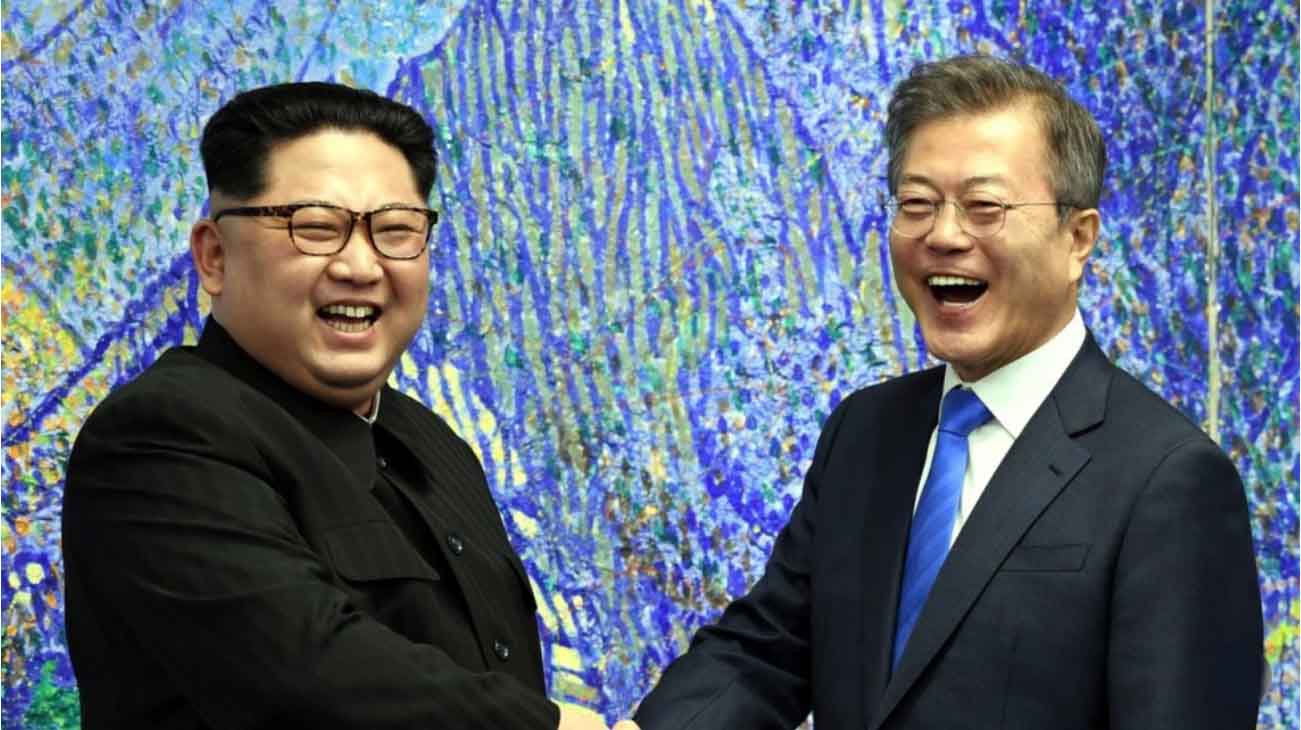
There is a pervasive sense of relief in East Asia, the United States, and throughout the world regarding the dramatic reduction in tensions between the two Koreas. Encouraging signs emerged already with the cordial atmospherics at the Winter Olympics in February, but recent developments have greatly accelerated that process. The sight of North Korean leader Kim Jong-un stepping across the de facto border at the Demilitarized Zone was especially powerful symbolism. Even more important in terms of substance, was the agreement that Kim and South Korean president Moon Jae-in signed at their April summit meeting vowing to end the state of war between the two Korean states.
There is considerable speculation about why the easing of tensions is taking place and the significance of the change. Hardliners in the United States and Japan remain highly suspicious of Kim’s moves. They contend that he is taking advantage of a gullible South Korean leader and is simply trying to buy time while North Korea continues to build its nuclear arsenal and ballistic missile systems. Such skeptics caution the Trump administration not to be taken in by Pyongyang’s new charm offensive. Even more moderate observers note that Pyongyang has not yet made truly substantive concessions.
Other analysts are more optimistic that a fundamental change in North Korea’s policies is taking place. Some contend that Kim has concluded that his regime will not survive if he continues to engage in provocative actions—especially regarding the nuclear issue. The Trump administration’s extremely hardline positions, including deploying more U.S. air and naval forces to Northeast Asia, along with the president’s threatening rhetoric, so the argument goes, convinced Kim and the rest of the North Korean leadership that a course correction was imperative or Washington might launch air and missile strikes.
Other experts who believe that prospects for peace are now real, speculate that Kim may want to improve the current security environment so that he can pursue economic reforms along the lines China adopted in the late 1970s. Some analysts give China considerable credit for the onset of détente between the two Koreas. Much of that speculation involves the mysterious meeting between Chinese President Xi Jinping and Kim during the latter’s sudden trip to Beijing with a North Korean economic delegation in late March.
The initial steps that Kim and Moon have taken are encouraging, and they provide the foundation for a lasting peace on the Peninsula. But they are just initial steps, and many thorny obstacles remain. Both the United States and China must make some difficult decisions to advance the embryonic peace process.
North Korea’s demands are long-standing and straightforward. Pyongyang wants a full, formal treaty ending the Korean War. The 1953 armistice suspended combat operations, but it did not resolve the underlying diplomatic and political questions. Both the United States and China would have to add their signatures to the Kim-Moon agreement (or a broader treaty) to achieve that goal.
Pyongyang wants Washington to extend diplomatic recognition to the Democratic People’s Republic of Korea (DPRK) and lift the economic sanctions that Washington and its allies have imposed on that country in stages over the decades. Those two issues are certain to be at the forefront of any summit meeting that takes place between Kim and President Trump.
Other issues that will be on a summit agenda include Pyongyang’s demand for an end to the annual military exercises between U.S. and South Korean forces, the withdrawal of U.S. “nuclear and strategic assets” from South Korea, and, at some point, the withdrawal of all U.S. forces from the Peninsula. Washington’s key demand will be for North Korea’s full denuclearization, including the shipment of all existing warheads out of the country and a system of inspections to ensure Pyongyang’s ongoing compliance with a nonnuclear status.
Washington must decide if it is willing to make all—or at least most—of those concessions in exchange for North Korea’s ironclad agreement to relinquish its existing nuclear weapons and forego any future nuclear ambitions. Unless U.S. leaders are prepared to take that step, hopes for a lasting peace on the Peninsula will be stillborn.
In addition to meeting such North Korean demands, the Trump administration must be willing to offer the DPRK a nonaggression pact or security guarantee. North Korean leaders have cited Washington’s double cross of Muammar Qaddafi after the Libyan leader terminated his country’s embryonic nuclear program. Is the United States willing to reassure the North Koreans with a written agreement that the United States is now out of the forcible regime-change business?
China’s role regarding security issues is equally crucial. Washington may well press Beijing to provide a guarantee that North Korea will remain nonnuclear, if the United States meets Pyongyang’s demands. Would Beijing be willing to offer such a guarantee of good behavior on the part of its longtime ally?
Finally, North Korea may well want China to add its signature to any security guarantee that the United States offers. Just as American leaders are likely to be wary of a paper promise of denuclearization from Pyongyang, Kim is not likely to place extensive trust in a promise from Washington that the United States will not pursue forcible regime change.
There would be a significant potential downside, though, to China formally endorsing either a guarantee of Pyongyang’s commitment to remain nonnuclear or Washington’s renunciation of regime-change ambitions toward North Korea. A violation of either agreement could draw China into a volatile situation as a guarantor power, including the danger of a direct military confrontation with the United States. Chinese officials need to ask themselves if they are willing for their country to incur such risks.
There are still many questions to resolve and daunting obstacles to overcome before lasting peace can come to the Korean Peninsula. The recent conciliatory moves between the two Koreas are encouraging and gratifying, but they should be viewed with caution and restraint. It might be appropriate at this point to purchase a bottle of champagne for possible celebration of a peace accord, but it is far too early even to put that bottle on ice, much less to pop the cork.


